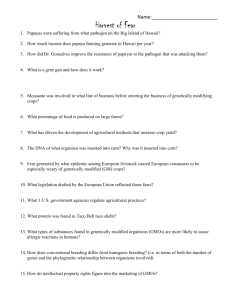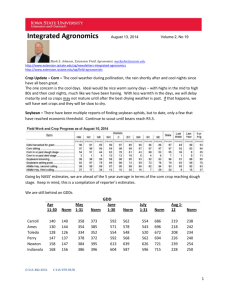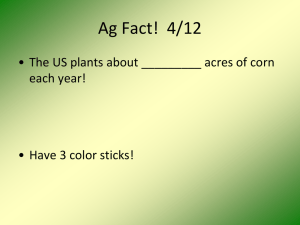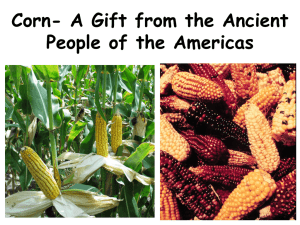Printer-friendly version
advertisement
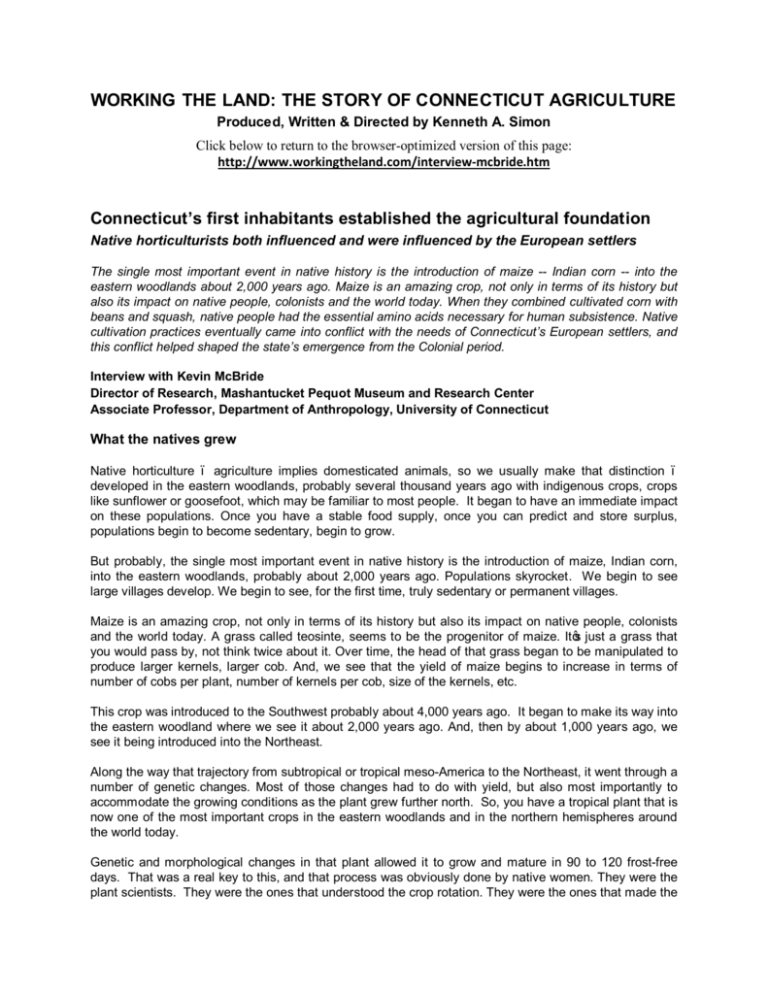
WORKING THE LAND: THE STORY OF CONNECTICUT AGRICULTURE Produced, Written & Directed by Kenneth A. Simon Click below to return to the browser-optimized version of this page: http://www.workingtheland.com/interview-mcbride.htm Connecticut’s first inhabitants established the agricultural foundation Native horticulturists both influenced and were influenced by the European settlers The single most important event in native history is the introduction of maize -- Indian corn -- into the eastern woodlands about 2,000 years ago. Maize is an amazing crop, not only in terms of its history but also its impact on native people, colonists and the world today. When they combined cultivated corn with beans and squash, native people had the essential amino acids necessary for human subsistence. Native cultivation practices eventually came into conflict with the needs of Connecticut’s European settlers, and this conflict helped shaped the state’s emergence from the Colonial period. Interview with Kevin McBride Director of Research, Mashantucket Pequot Museum and Research Center Associate Professor, Department of Anthropology, University of Connecticut What the natives grew Native horticulture – agriculture implies domesticated animals, so we usually make that distinction – developed in the eastern woodlands, probably several thousand years ago with indigenous crops, crops like sunflower or goosefoot, which may be familiar to most people. It began to have an immediate impact on these populations. Once you have a stable food supply, once you can predict and store surplus, populations begin to become sedentary, begin to grow. But probably, the single most important event in native history is the introduction of maize, Indian corn, into the eastern woodlands, probably about 2,000 years ago. Populations skyrocket. We begin to see large villages develop. We begin to see, for the first time, truly sedentary or permanent villages. Maize is an amazing crop, not only in terms of its history but also its impact on native people, colonists and the world today. A grass called teosinte, seems to be the progenitor of maize. It’s just a grass that you would pass by, not think twice about it. Over time, the head of that grass began to be manipulated to produce larger kernels, larger cob. And, we see that the yield of maize begins to increase in terms of number of cobs per plant, number of kernels per cob, size of the kernels, etc. This crop was introduced to the Southwest probably about 4,000 years ago. It began to make its way into the eastern woodland where we see it about 2,000 years ago. And, then by about 1,000 years ago, we see it being introduced into the Northeast. Along the way that trajectory from subtropical or tropical meso-America to the Northeast, it went through a number of genetic changes. Most of those changes had to do with yield, but also most importantly to accommodate the growing conditions as the plant grew further north. So, you have a tropical plant that is now one of the most important crops in the eastern woodlands and in the northern hemispheres around the world today. Genetic and morphological changes in that plant allowed it to grow and mature in 90 to 120 frost-free days. That was a real key to this, and that process was obviously done by native women. They were the plant scientists. They were the ones that understood the crop rotation. They were the ones that made the selection for certain traits. So, when that crop was finally introduced into the eastern woodlands it was perfectly suited after thousands of years of manipulation. Native horticulture, I think, also has a more lasting legacy in that corn or maize, today, is probably the single most important crop around the world. It’s very adaptable and was adopted by most societies. It th provided a food base for the English when they arrived here in the 17 century. It continued to be the most important crop in New England probably through the present day. Native corn fields were generally hacked, if you will, out of the forest. The planters would probably first go in and take the bark off trees to kill them, to let the light in. They would then burn off the underbrush and create small hills that they would plant the corn in. The process of hilling would help establish the roots better and give some stability to the plants. Also, raising the plant a few inches above the surrounding ground was critical because corn maize is a tropical plant and any hint of frost would kill it. By raising the crop up a little bit, you can buy yourself a couple of extra weeks of growing time. The corn hills would be scattered within a three-quarters of an acre, perhaps an acre parcel per family. They were about 3 feet across and three feet apart. Once the corn was growing they would then plant beans, which would grow up around the stalk. Then they’d plant squash and pumpkins in the valleys between the hills both to keep the weeds down and to provide an additional crop. The crops, maize beans and squash, are probably the most critical crops in native horticulture. They are called the “Three Sisters.” They’re always grown together. They’re always mentioned together. They’re always consumed together. Maize alone, beans alone, squash alone would not provide the essential amino acids to be able to support a population. But when they come together the three provide the essentials for human subsistence. And that’s when we begin to see a huge impact on their populations. Natives were subsistence farmers in the sense that they were not producing a crop for market, although they would certainly trade corn. Those groups who were producing a large surplus in areas like the Connecticut Valley for example, might trade that crop for other commodities to native people to the north who weren’t able to grow corn because it was just too far northward to produce the crop. We see many accounts in European records of native people’s trading various kinds of foods for other kinds of products. For example, horticulturists in southern New England would trade corn to northern hunters for furs, meat, things of that nature. And that had been going on for obviously thousands of years. Some native people had particular kinds of plants or crops that they might trade for different purposes. Some of those crops were actually provided to sachems who were placing other groups in the tributary status to them. So, for example, there are accounts of the Pequots receiving food supplies from neighboring tribes who were tributary to them to help pursue their wars or other kinds of tributary functions. Conflicts over good agricultural land When the English arrived here – we’re talking Plymouth Colony in the 1620s – they were searching for a place for their settlement, which had good agricultural land. They selected Plymouth as that location for a couple of reasons. One, it had already been cleared. And the reason it had been cleared is native people had been farming there for centuries. When Europeans arrived and began growing crops for their subsistence, they quickly began to try to produce a surplus so they could trade it, sell it around the Caribbean and England, to help diminish their debt. For Europeans, the largest labor investment in producing an agricultural field was clearing land and stumping it. If you didn’t have to do that, you were years ahead in terms of production. The Europeans found fields of good agricultural land they didn’t have to clear because all the native people in Massachusetts Bay had died in a great epidemic of 1617 to 1619. Now, most of the Europeans probably didn’t have a lot of knowledge of agricultural production. Many of them were merchants, although there were some yeomen with them who had knowledge of farming technology. Also, the crops they brought over with them weren’t conducive for growing in New England, with its harsh climate, unpredictable weather. They were susceptible to a lot of blight and disease. The crop that did well for them was corn. And, native people they encountered very early at Plymouth, a gentleman by the name of Squanto in particular, showed them the best methods for planting corn in the Indian way. And, the English quickly became dependent on corn as their major crop. When the English began a migration out of Massachusetts Bay and Plymouth Colony into Connecticut, they selected two areas, the Connecticut River Valley and the Coastal Plain of Connecticut, because they were where the best agricultural soils were. The Connecticut Valley was by far then, and is today, one of the richest agricultural areas probably in the world. When the English arrived in the Connecticut Valley, they quickly began to plant maize. What happens over time is that the native people’s requirement for land for horticulture and for subsistence hunting and gathering is fundamentally inconsistent with English land needs for agriculture. Native people need large areas. The English need smaller parcels of land for a more intensive form of agriculture because they have domesticated animals to provide manure. But they also need large amounts of land, too, not only to grow their own food crops but also to produce hay and fodder for their domesticated animals. And the English populations are growing much more quickly than the native population. And growing population needs land. Within a generation or two, you begin to see these conflicts develop between native people and native needs for agriculture, and English people and English needs for agriculture. The ultimate reasons for the conflicts between native people and Europeans was land. While the Pequot War, for example, wasn’t over land per se, land was an underlying motive. It certainly was in the minds of the English. A better example of a conflict that really involved land was King Phillip’s War of 1675-76. That conflict really was over the growing need by the English for land, the encroachment upon native land on a consistent basis. And native people recognized that the English were growing very rapidly and in a very short period of time their traditional life ways would vanish if they didn’t take some steps. It’s interesting to note that we have this perception that while the English dramatically changed the landscape when they arrived, the native people were sort of at one with the landscape and didn’t alter it that significantly. In fact, nothing can be farther from the truth. Both native and English systems of agriculture had an impact, although a different impact, on the landscape. The premise is that native people who had been living on this landscape for at least 12,000 years were the ultimate ecologists, the ultimate managers, as most horticulturists and pre-industrial societies, most hunters and gatherers, are. We have good reason to believe that they began to manage the forests as early as 8,000 years ago. By managing the forests, I mean sort of culling unwanted trees and encouraging trees that produce the crop for them, the nut trees – chestnut, hickory, egg corn, walnut. There’s archeological evidence that suggest that. And we also begin to see a process whereby native people systematically burn over the forest to encourage secondary growth for herbaceous plants, which they would eat. These plants also would be usable by deer. So what the Europeans encountered on the land was thousands of years of native use and management of that environment – for agricultural purposes in the previous 2,000 years and a sort of forest managing for the previous 6,000 years. But the Europeans did not perceive it that way. When the Europeans arrived they saw a landscape that, from their description, was very park-like, very open. They called them champion fields, wide open fields much like they saw in England. They believed they were seeing a “natural landscape.” They saw patchworks of fields and abandoned fields, fields where secondary growth plants were coming up because the natives abandoned their corn field after two or three years because they didn’t apply fertilizer on a consistent basis. But in European eyes, this land was unmanaged. It wasn’t tamed. Native people weren’t building edifices. They weren’t fencing. They really didn’t own the landscape, from a European perspective, because they didn’t manipulate it. When the Europeans come in, they start fencing, bounding. There’s a different perspective on ownership. Ownership wasn’t through use as it was in a native perspective, but through a deed or title. And that dynamic just began to affect both groups. The English quickly imposed a system of agriculture and the landscape dramatically changed it. The Europeans needed to create a surplus to become involved in a market economy to pay off this process of colonization. Corn, as well as other forest products tended to be fairly quickly adopted as a form of currency. You see bushels of corn, for example, going to the Caribbean and going to England as surplus foods. The Caribbean trade was largely supported by English farmers here. Native and European crops One of the more interesting things we see about this English/Native interaction in terms of agriculture/horticulture was the plants and animals first adopted from the Europeans by native people. These included pig very early, apple, peach and root crops, such as beet, radish, parsnip, carrot that we see in 17th century native sites. This was a surprise to us. Initially we were thinking this may reflect a major transformation in native horticultural practices. But on close examination, it really doesn’t reflect dramatic change. If you look at these species of plants and animals that native people are adopting from European, they’re very similar to traditional crops. Pig, for example, basically takes care of itself in the woods. It sort of runs free, like a small deer. Apple, peach -- again, no different if you accept the notion that native people are managing their forest for thousands upon of years, culling unwanted trees and encouraging wanted trees. What we’re now finding out about native horticulture is that it involves a lot more than maize, beans and squash. It also involves the purposeful cultivation of some root crops and the encouragement of others in abandoned fields such as yellow nuts-edge and Indian cucumber – very, very important root crops to native people. The addition of beet, radish, parsnip, carrot from the Europeans is no different. It’s just an add-on to an existing system. And they’re not having to make many modifications to that system to accommodate the crops. The English really began to dominate the landscape – politically, economically, socially, militarily and agriculturally – after King Philip’s War in the third quarter of the 17th century. The remaining native communities after King Philip’s War were on greatly reduced land-base basis. You have a situation in which these native people are placed in enclaves. th The Mashantucket Reservation, 2,000 acres in the early 18 century, was probably adequate to support a relatively small population of a couple hundred people as long as they had access to other environments for fishing, hunting, gathering. With the growing English population after King Phillip’s War, doubling within a couple of generations, those reservations that were at one time adequate began to become reduced in size because of English encroachments. And access to those other environments is reduced. You have a population trying to maintain themselves on these reservations. What do they do? That’s when we really begin to see an interesting process of selective adoption of even more European agricultural technologies. Domesticated animals are adopted such as cow, more pig, sheep or goat. (We really can’t tell the difference between sheep or goat in the archeological record.) But, interestingly enough, we still don’t see the adoption of European crops such as wheats, ryes, things of that nature. Although there probably would have been the need of some kind to sustain a herd of animals. Even the adoption by native people of European species of animals was adapted into their own system. For example, they weren’t keeping herds of dairy cattle. They weren’t producing cheese or milk or butter. Primarily because they were lactose intolerant and partly because they still weren’t involved in a market economy. Instead cattle were being used as a food source. Goat and sheep were being used primarily as a food source, probably not as a production of wool or things of that nature. So we do see more and more of these animals being integrated into native subsistence practices but in a native way, not a European way. We’re still looking at the selective adoption with European animals becoming very important because you can sustain an animal as a free-ranging animal fairly easily on a small acreage of land. You don’t have to necessarily grow a lot of hay and fodder as long as there are relatively few animals and they can sustain themselves on what was probably was the patchwork of abandoned fields and secondary growth. Corn built community If you look at traditional native horticulture, it really was a community enterprise. Yes, women were primarily responsible for crop production, maintaining the fields, but men would also be involved in the initial clearing and preparing the land and during harvest as well, if needed. The community aspect of native horticulture is reflected, too, when you look at the native ceremonies and rituals involving corn. It’s amazing how important this crop is in native life, native world view, native spirituality, ceremony, ritual. It’s the underlying basis not only for the subsistence but for a lot of their ceremony or ritual activity in terms of harvest, planting. Just as important is to understand its role in life ways, not only in the colonial period, but today. Corn is an important crop because it sustained the development of some of the most important social, political institutions in North America and South America. The complex societies of Mexico, Peru, middle America, in the Mississippi Valley were all based on corn agriculture. Even today we know that dairy farming in Connecticut used to be and still is based upon corn. That silage the cows eat throughout the winter is all corn. And, that crop is exported throughout the world. It’s still flourishing today – from China to Africa to Europe, and, of course, in the Americas.


